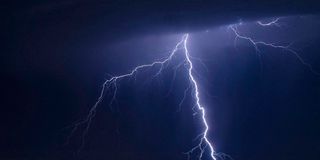Explainer: Understanding lightning and the western Kenya connection

Lightning flashes. Lightning is a giant spark of electricity in the atmosphere between the clouds, the air, or the ground. In its early stages of development, air acts as an insulator between the positive and negative charges in the cloud and the ground.
On Saturday evening, June 29, a heavy downpour accompanied by lightning and thunder hit Elukoto village in Mumias East, Kakamega County.
Inside one of the houses in the area Nicholas Omamo Walunya, his wife, Demtila Osimbo, and their two guests, who had sought shelter, conversed in low tones as the heavy rains continued to pound.
“While we were busy talking, a strong frightening lightning accompanied by thunder, struck my wife and one of the guests identified as Rose Chimila from Shikomari in Navakholo, killing them instantly. My brother and one of his children, who were also in my house, were injured by the strike,” said Mr Walunya.
David Omamo and Difina Mukoya were rushed to Makunga Sub-County Hospital and St Mary’s Mumias Hospital respectively for treatment.
Intriguingly, the incident occurred on the same day another victim of lightning, Rashid Andewa, was being buried in the neighbouring Shianda village. The twenty-six-year-old man was struck a week prior.
Ms Anita Osundwa, sister of the late Demtila, said she had spent the entire day with the deceased at her home and that her death had come as a big surprise to the family.
“I am yet to come to terms with the death of my sister. I came to visit her for a day without knowing that I was bidding her goodbye,” said Ms Osundwa amid sobs.
So what is Lighting and what should one know about it?
Here is an explainer:
What is lightning?
Lightning is a giant spark of electricity in the atmosphere between the clouds, the air, or the ground. In its early stages of development, air acts as an insulator between the positive and negative charges in the cloud and the ground.
Lightning occurs when a positive charge builds up on the ground beneath the cloud, attracted to the negative charge at the bottom of the cloud.
When the ground’s positive charge concentrates around anything that sticks up like trees, lightning conductors, human beings, and animals, it connects with the negative one, and a spark of lightning strikes.
Western Kenya
Western Kenya is a high-risk zone in terms of lightning. Experts have identified the region to be susceptible to lightning strikes because of its hilly nature.
Lightning activities are said to be most frequent in the highland areas of Teso and Samia in Busia County as well as Lugari, Navakholo, and South Wanga in Kakamega County. This is due to the orographic effect and abundant supply of moisture in the mentioned areas.
Lightning is said to be one of Kenya’s most unpredictable, underrated, and neglected natural weather-related hazards, which strikes with frequencies coinciding with the rainy seasons of the area.
Lightning shocks
Mr Benjamin Bahati, the chief meteorologist in Busia county said lightning shocks are more severe than industrial shocks.
“Whereas most industrial shocks generate between 20 to 60 kilovolts of energy, lightning generates 300kv. In addition to the 300kv of energy coursing through the body when lightning strikes, the power of the strike heats the surrounding air to 27,000 degrees Celsius, causing third-degree burns at the bolt’s entry and exit points,” explained Mr Bahati.
He said the damage is worse if one is holding a metal object as this increases the likelihood of being struck in the first place.
A report by the University of Nairobi (UoN) indicates that in Kenya, 66 per cent of the 47 counties are in high lightning zones.
Lightning arresters
Lightning strikes can be prevented through the installation of lightning arresters. These are devices that are installed on buildings to safeguard against damage caused by lightning strikes.
Typical lightning arresters have a high-voltage terminal and a ground terminal. When a lightning surge travels to the arrester, the current from the surge is diverted through the arrester, in most cases, to Earth.
Arresters consist of a series of inductors and spark gaps that are typically installed near a critical entry point or appliance so that when a bolt of lightning strikes, the arrester activates and deflects the lightning to the ground, where it disperses harmlessly.
They don’t stop lightning strikes, but they limit the charges and divert them, giving a safe route to pass through the ground.
There have been calls by residents of Elukoto village to the government to install arresters in the area to curb incidents of deaths caused by lightning strikes.
Mr Benson Wafula, a resident, blames Mumias East MP Peter Salasya for turning a deaf ear to their pleas.
“We have been knocking at the doors of government offices including the Mumias East NG-CDF office requesting for lightning arresters but our cries have not been heard. The result is now shocking the whole region,” said Mr Wafula.





